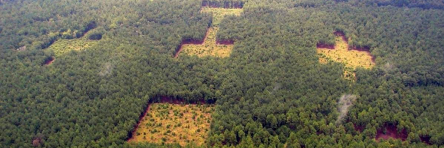A new study released last week documents one of the largest ever, long-term habitat connectivity experiments. The findings show clear, persistent benefits in maintaining species biodiversity. (Image: Washington Post)
The importance of connecting isolated blocks of habitat — or conserving existing connectivity — has been a core tenet of land conservation for a number of years. Scientists have now completed one of the largest scale, long-term studies of connectivity, and it demonstrates the biodiversity benefits.
As reported in the Washington Post, the study was carried out over decades amidst a large timber plantation managed by the US Forest Service in South Carolina. The native habitat was formerly longleaf pine savanna, subject to regular but not intense fires. The researchers constructed multiple large, several-acre squares of restored savanna and connected some of them with restored corridors, as in the image above. The restored savanna has been regularly burned by the Forest Service to mimic natural conditions.
In the report published in Science, researchers report that over 18 years they sampled plant species in the restored pine savanna and found “corridors reduced the likelihood of plant extinction in patches by about 2% per year and increased the likelihood of patch colonization by about 5% per year. These benefits continued to accrue over the course of the 18-year experiment. By the end of monitoring, connected patches had 14% more species than unconnected patches.”
The Washington Post story notes: “The percent changes may seem small, ‘but the important point is that these rates are on an annual basis,’ [study author Ellen] Damschen said, ‘just like your bank account, with an annual rate of interest.’”
This is one more piece of evidence that protecting and restoring hubs and corridors to maintain species diversity is critical — is vital to addressing the call for protecting thirty percent of the planet by 2030 described in a prior Lightning Update. Further, it reaffirms the approach taken by the Chesapeake Conservation Partnership in setting a specific goal for habitat conservation and in mapping the set of important hubs and corridors that must be conserved here in the watershed.
Lightning Update is a regular communication of the Chesapeake Conservation Partnership. Any opinions expressed are those of the authors and do not necessarily reflect positions of the Partnership or member organizations.
To share a success story, news, or important event, send your information to:
Support for the Chesapeake Conservation Partnership is provided by:
National Park Service Chesapeake
EPA Chesapeake Bay Program
USDA Forest Service
Pennsylvania Department of Conservation & Natural Resources
Maryland Department of Natural Resources
Virginia Outdoors Foundation
US Fish & Wildlife Service
Chesapeake Conservancy
The Chesapeake Conservation Partnership is co-convened by:




